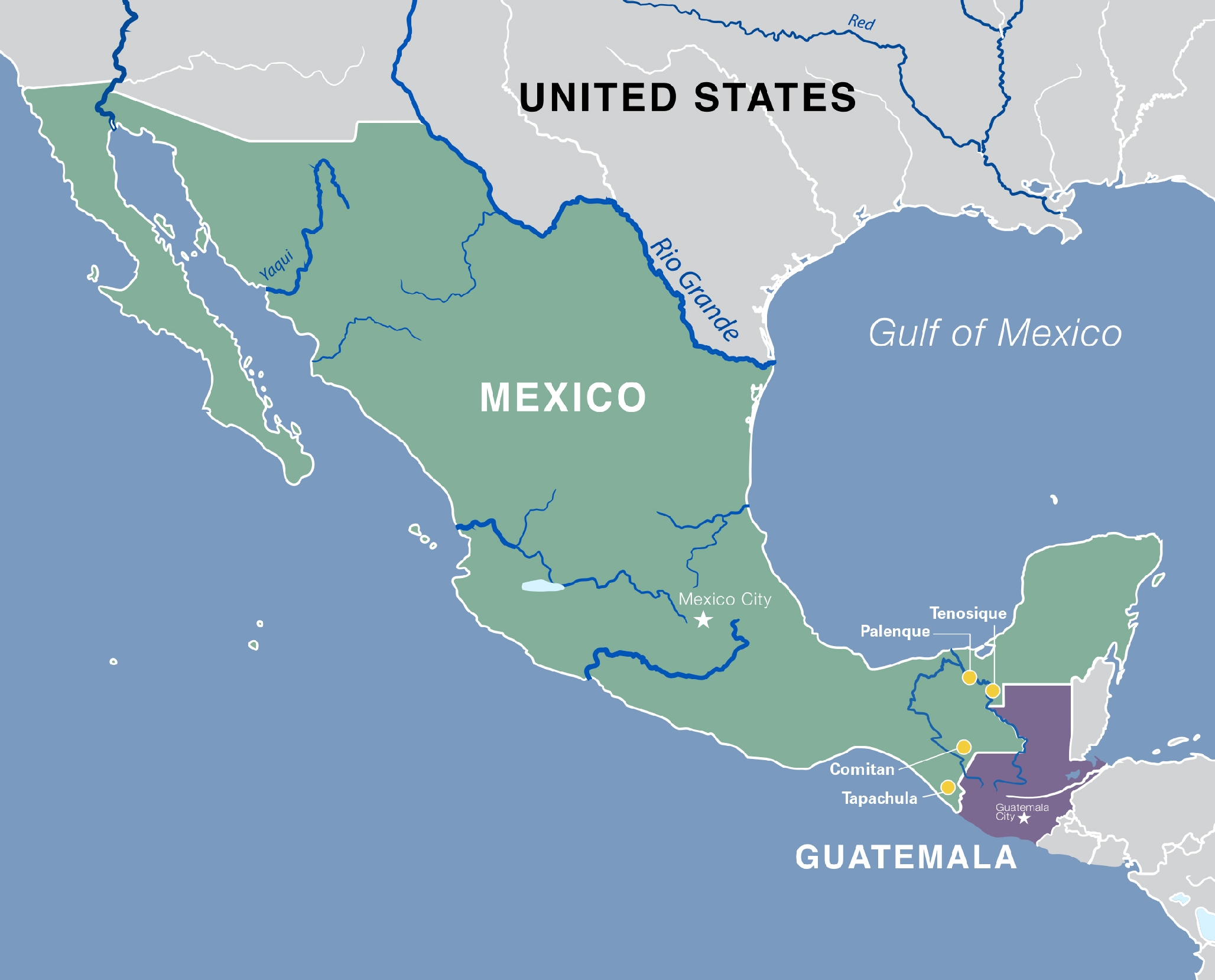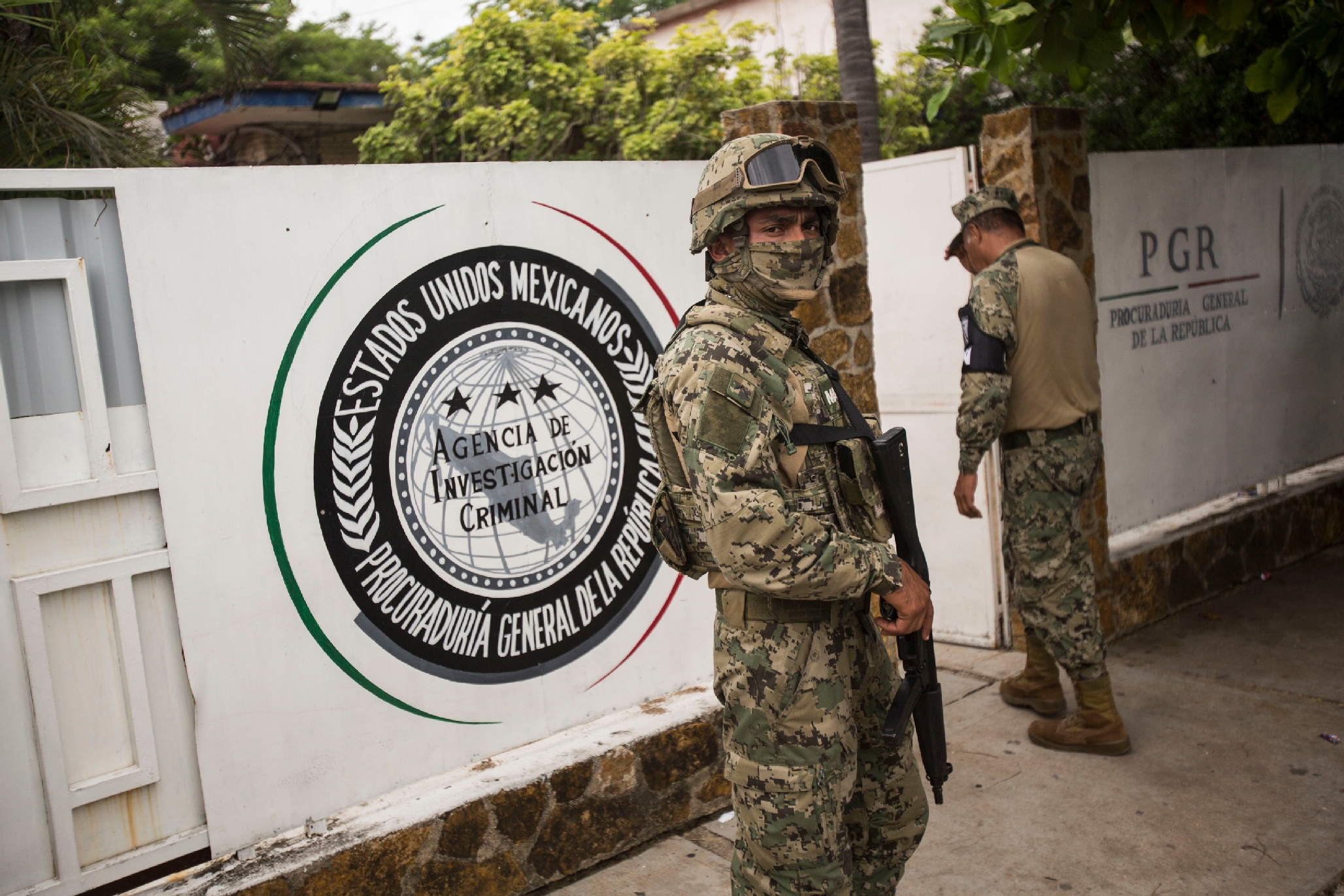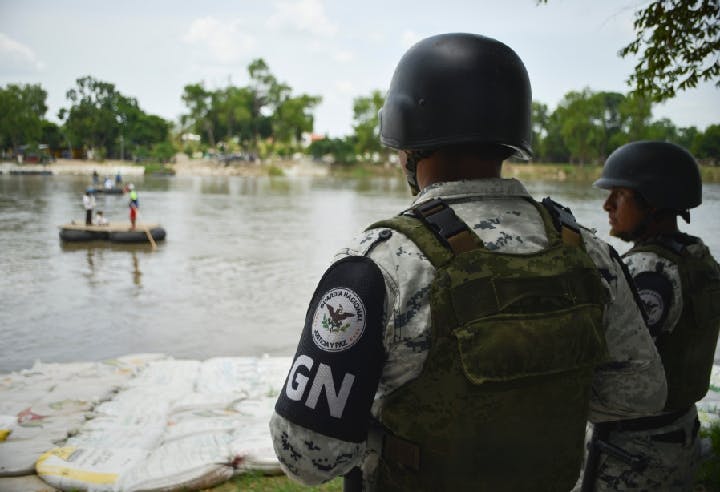Fall 2019
Southern Exposures
– Eric L. Olson
Mexico’s border with Guatemala doesn’t garner headlines. But U.S. migration policy depends on the hopes and fears of those who head north across it.
When a record number of Central American migrants reached the U.S. border via Mexico this past spring, President Donald J. Trump reacted in several ways.
His most important response to this surge – which reached a peak in May 2019 at 132,859 total apprehensions – was a threat to impose significant new tariffs on Mexico unless its government took immediate action.
Hastily arranged meetings yielded an agreement. One provision was that Mexico would deploy a newly formed security force, the Guardia Nacional, or National Guard (NG), to its southern border to staunch the flow.
Over six days in August, I visited Mexico’s southern border. I spoke with migrants and shelter workers and listened to the stories of those trying to navigate the tumult; Mexican asylum officials and security forces, and United Nations personnel.

Mexico has long seen itself as a transit country, with a welcoming reputation. It is a nation that has eschewed the criminalization of migration, viewing it as an administrative matter.
But the events of the past few months have made Mexico’s border with Guatemala newly-contested territory in U.S. efforts to control migration.
What I discovered on my journey was that migrants face an increasingly U.S.-style border control policy, improvised by Mexico after the May agreement. Chaos and confusion has ensued. Desperation is driving migrants to more extreme measures to cross a daunting new barrier to the United States.
I also saw that a border regime based solely on punitive measures designed to stop migration is not enough. Migrants hunger for an end to corruption, and for governments that will invest in their schools and healthcare. They want policies that will renew their hope in the communities they are leaving.
The Dire Choice to Leave
The August heat in Tenosique can be staggering. It is the first major city many Central Americans encounter after crossing into Mexico from Guatemala, and the most direct route to crossing points into Texas along the lower Rio Grande Valley.
At a shelter for migrants, I fell into conversation with “Dolores,” a mother who had fled here with her daughter. They arrived from Choluteca – a desperately poor area in the south of Honduras, sandwiched between El Salvador to the east, and Nicaragua to the west.
I felt lightheaded as we tried to find shade to continue our conversation. Dolores’ home, along with much of Choluteca, was devastated by Hurricane Mitch in 1998. But she remained for almost two decades, eking out a living selling tortillas and doing other odd jobs. The continuing extortion of her small business by multiple gangs eventually offered a simple but dire choice: “Take my daughter and flee, or face the consequences.”
Mexico has long seen itself as a transit country, with a welcoming reputation.
An illness that befell Dolores’ daughter on the journey north made the trip more arduous. The shelter where I met Dolores – La 72 – had a small dispensary run by Doctors Without Borders. The care they provided would soon allow them to continue their journey to the United States.
The numbers of Central American migrants arriving in August had diminished from a peak in early summer, but several UNHCR representatives reported a continuing and significant flow. When I visited, La 72 was nearly full to capacity, with roughly 85 percent of its residents from Honduras
Dolores’ story opens a window to some of the reasons migrants leave their homes and head north. Many surveys suggest economic insecurity (poverty, lack of employment, hunger) is the primary factor in a decision to leave. Fears for personal safety also drive migration, as well as the failure of government to provide basic services.

“Saliendo Adelante: Why migrants risk it all,” a recent study based on 2,400 field interviews conducted in 2019 in El Salvador, Guatemala, and Honduras with substantive migration confirms many of these findings. The report found that economic pessimism was a strong predictor of migration, especially from high migration municipalities in Honduras. The study also found that unemployed persons were twice as likely to migrate.
The report’s researchers also found that criminal victimization of all sorts (homicide, but also extortion, and robbery) was also a major predictor of migration. Fully 38 percent of Salvadorans surveyed cited encounters with crime as a primary reason for migrating.
Armbands and Chain of Command
Migration from the Northern Triangle, for whatever reason, now faces significant new obstacles after the spring 2019 crisis between the United States and Mexico.
The situation is much changed from four years ago, when I visited the lower Suchiate River, near Tapachula and Ciudad Hidalgo, after another migration emergency: the so-called Unaccompanied Minor crisis of 2014. That year, nearly 70,000 Central American minors turned up at the U.S. border seeking protection from gang violence and a better future.
.jpg)
Back then, the U.S. pressed Mexico to increase immigration enforcement and tighten border controls along its southern border. But Mexico’s overall strategy continued to encourage orderly migration, especially from neighboring Guatemala. Mexico increased enforcement but did not adopt a U.S.–style border security strategy.
On my return in August 2019, the U.S. approach had won out. Security forces now guard Mexico’s southern border, much like the Border Patrol does in the United States. In some places, including along the lower Suchiate River, troops are stationed every 100 yards or so along the riverbank. Mobile deployments with truckloads of armed personnel are also visible in the region.
National Guard troops are at the heart of this effort – a hurriedly-deployed patchwork of security forces, including the Navy (SEMAR) and Army (SEDENA), as well as the Federal Police. At present, they wear the uniform of their particular service branch, with a slipover armband that reads “GN.” The National Guard troops with whom I spoke made it clear they would return eventually to their original military units.
A border regime based solely on punitive measures designed to stop migration is not enough.
Time-limited assignments and a lack of common uniforms speak to major challenges to the plan: How will these diverse personnel meld into one cohesive NG force? Who will be in command? (The NG is currently under the command of retired army general Luis Rodriguez Bucio.)
Finally, what is the National Guard’s mission? One member of the force described it as “rescuing” Central Americans trying to enter Mexico without documents. It remains to be seen whether a strong dissuasive, if passive, presence in regions such as the lower Suchiate River can effectively stop the flow of migration.
Protocols and Bottlenecks
The National Guard deployment is an outward projection of force at Mexico’s southern border. But immense confusion over border policies simmers under the surface. A backlog of asylum cases and other bureaucratic snafus have created a growing bottleneck of migrants in Tapachula and elsewhere, increasing the journey’s dangers and risks.
Another U.S. initiative – the so-called Migrant Protection Protocol (MPP) program – has had an outsized effect. It requires migrants attempting to enter the United States to stay in Mexico as their asylum claims are processed.
.jpg)
The MPP was introduced by the Department of Homeland Security (DHS) earlier in 2019. The agency argued that the protocol “will help restore a safe and orderly immigration process, decrease the number of those taking advantage of the (U.S.) immigration system, and the ability of smugglers and traffickers to prey on vulnerable populations, and reduce threats to life, national security, and public safety, while ensuring that vulnerable populations receive the protections they need.”
But the new protocol created a radical shift in Mexico’s immigration policy, obligating its government to receive Central Americas (and other non-Mexicans) waiting to file a U.S. asylum claim. And there is even growing concern that the MPP has been stretched to include migrants detained by the U.S. who are not seeking asylum.
Previously, many non-Mexicans seeking asylum in the U.S., or attempting to enter without proper documentation, were allowed to remain (sometimes in detention), as their cases were adjudicated. Those whose claims were denied were deported from the U.S. or removed to their country of origin.
The new protocol’s aim to create order and safety for migrants are undercut by the large number of non-Mexican migrants – an estimated 30,000 and growing – who now wait near the U.S. border in cities including Tijuana, Ciudad Juarez, Nuevo Laredo, and Matamoros.
These cities are known for the significant presence and territorial control exercised by criminal organizations, including those devoted to migrant smuggling and exploitation. They are also among the most violent municipalities in Mexico. (In August, for instance, Tijuana was ranked as the most dangerous city in the world.)
The Migrant Protection Protocol (MPP) program created a radical shift in Mexico’s immigration policy.
Ripples from the MPP have also reached Mexico’s southern boundary. On my visit to the border near Tapachula and Ciudad Hidalgo, I encountered three buses that had departed the northern cities of Nuevo Laredo and Matamoros just a day before. The buses were loaded with migrants, presumably Central Americans, who would be released at the Ciudad Hidalgo border crossing point.
Neither the UN’s International Organization for Migration (IOM) nor its Office of the UN High Commissioner for Refugees (OUNHCR) were involved in arranging the journey. These migrants were unaccompanied by officials from those agencies or the Mexican government. The bus drivers told me that Mexico’s foreign ministry (the Secretaria de Relaciones Exteriores, or SRE) had hired them.
I also was unable to confirm what information the migrants were given before boarding. Some passengers reported they were told they would be taken to a safer place in Mexico to await their chance to present their U.S. asylum case. It was unclear if the migrants understood the potential risks of returning home to await adjudication of their case in the United States.
Eventually, the migrants separated into two groups as they disembarked at the border crossing. One group sought shade from the blazing sun as they considered their options before eventually heading back into Mexico. Migrants in the second group entered the border crossing area to speak with Mexican migration officials. They requested a document to guarantee them reentry and safe passage to the U.S. border when their asylum case is called, but Mexican immigration officials told them no such document was available so the migrants simply returned across the bridge into Guatemala, quite possibly jeopardizing their ability to seek asylum in the U.S.
In response to questions about the buses, SRE reported that the migrants were provided “free, secure, and voluntary” transportation away from the U.S.-Mexico border to safely await a hearing date in the United States. Yet being deposited 1000 miles away at Mexico’s southernmost border only adds to the challenges that migrants face in securing shelter, food, and safety.
The Long Wait
Asylum claims are at the center of the current crisis, so the mission and funding of Mexico’s asylum agency, the Comisión Mexicana de Ayuda a Refugiados (COMAR) also represents a growing concern.
According to COMAR’s director, Andrés Ramírez Silva, Mexico could receive a record 80,000 asylum requests from Central Americans by the end of 2019. But the government is proposing to decrease COMAR’s budget to about $1.2 million in 2020. The agency lacks enough “secure” paper to issue formal documents, and cannot hire sufficient personnel, whether they translate for migrants from Haiti and African nations, or simply adjudicate the flood of claims.
Seeing COMAR’s operations in Tapachula firsthand points to how lack of resources has exacerbated the problems for migrants.
Those who seek asylum are usually given a document (constancia) that proves their case is underway and extends certain protections. But in the current backlog, asylum seekers are issued an informal document (citatorio) with the date for an appointment. Citatorios provide no legal protections or work authorization for its bearers.
.jpg)
Appointments may be up to four weeks later, so migrants are essentially left to fend for themselves, and even risk detention. They must also sign-in at COMAR or another designated site every 10 days as they wait. This requirement aims to keep asylum seekers closer to Mexico’s southern border, and failure to comply results in automatic forfeiture of the case.
Only after the asylum process is officially underway do migrants begin to receive any financial support. Officials at COMAR and UNHCR estimate the number of asylum cases that are abandoned at roughly 30 percent. Those who persist in their claims in the Tapachula region win approval 60 percent of the time.
"I have no faith that the government will resolve any of our problems."
Frustrating waits in an increasingly unwelcoming environment have seen migrants try to take matters into their own hands. On October 12, 2019, an estimated 2,000 migrants headed north from Tapachula after waiting weeks - and even months – for their claims to be processed. Mexican authorities confronted the migrants, who were primarily from Africa, the Caribbean, and Central America, dispersing the protest and detaining some of them.
Desperation and frustration has also led migrants to seek out alternative routes to the United States – and criminal smugglers to help them get across a tightening Guatemala/Mexico border. Church workers and UN officials say increased enforcement along the southern and northern routes has led migrants to try more remote and riskier routes on their way north. This often means migrants must rely on criminal smuggling networks with the capacity to navigate through distant and isolated areas.
In a recent communique, the La 72 shelter raised concerns that numerous migrant groups were even “disappearing” en route to Tenosique, presumably at the hands of criminal smugglers.
A Policy of Hope
Is the hardening of Mexico’s southern border working?
The DHS reports that the number of apprehensions between June and August 2019 fell 56 percent from totals in the period of March through May. And the June deployment of the National Guard sent the number of Central Americans detained in Southern Mexico to skyrocket, but those arrests have now levelled off.
Mexican authorities say these numbers reflect successful efforts to curb northward migration through their country. But whether it is a permanent downturn, or a short-term trend, is still to be seen.
Only after the asylum process is officially underway do migrants begin to receive any financial support.
What I saw on my visit was that the changes wrought over the past few months at this once-fluid border have slowed migration. But Mexico and the United States are not adopting and funding policies that would adequately address the underlying factors that spur Northern Triangle migrants to leave. And whatever the individual reasons, at the root of their collective experience is a growing overall sense of hopelessness. Institutions of government in the region – including the judiciary and law enforcement – are largely seen as corrupt and ineffective. Schools are failing, and access to basic healthcare is difficult.
As Dolores told me in Tenosique, “I have no faith that the government will resolve any of our problems. Every day we hear of corruption at the highest levels in our government. The politicians are not going to make things better. They just want to steal from us.”
.jpg)
Intensifying security at Mexico’s southern border cannot reverse this lack of governance and corruption. But proposals to restore hope for Central Americans in their communities might be a start.
This policy of hope will require partnering with Central American civil society, and – where possible – elements within these governments that are committed to ending corruption and impunity, and increasing transparency and accountability. Such a policy agenda would include:
Elections: Creating independent, nonpartisan, and trustworthy electoral systems. Battling campaign finance violations. Ending immunity for violating the public trust.
Rule of Law: Building merit-based systems to create an independent judiciary, prosecutors who prioritize corruption, and more professional civilian law enforcement agencies. Targeting extortion networks and violent crime with smart, evidence-based approaches.
Education and Health: Investing in education and safe schools. Equipping teachers and counselors to meet the needs of children facing domestic trauma and gang violence. Ensuring broad access to basic preventive healthcare, especially for poor and rural populations.
Economy: Providing increased technical training and workforce preparation. Investing in sustainable agriculture practices to cope with severe drought, rising sea levels, and climate change.
Most Central Americans would prefer to remain in their country, rather than risk the hardships and potential violence of migration to the United States. Yet border enforcement, apprehensions, and deportations have sown confusion, danger, and fear for those who do make the journey. Renewing migrants’ hope in their communities and their nations may be the surest path to ending this crisis.
Eric L. Olson is Director of Policy for the Seattle International Foundation’s Central America in DC program. He is also a Wilson Center Global Fellow, and served as the Mexico Institute and Latin American Program’s Deputy Director for 11 years. He has worked with the Secretariat for Political Affairs at the Organization of American States as a Senior Specialist on Good Governance, at Amnesty International USA as Advocacy Director for the Americas, and at the Washington Office on Latin America as Senior Associate for Mexico.
Cover: Mexican National Guards (GN) stand on the bank of the Suchiate River near Ciudad Hidalgo, Mexico in July 2019. (AP Photo/Idalia Rie)
